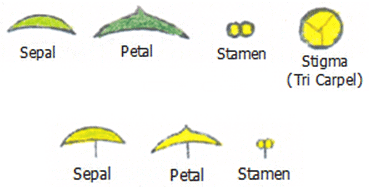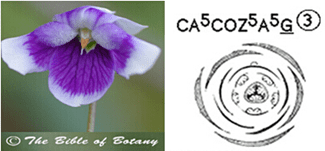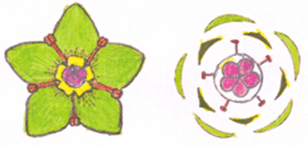Floral characteristics vary greatly from plant to plant and are the most useful part in the classification and identification of plants when available. See glossary pages 44-63.
Calyx or Sepals –Specialized leaves at the base of a flower not the petals.
Corolla or Petals –The coloured parts of a flower that forms a tube and is known as a corolla when united or as petals when free.
Stamens –The collective name of the anther and filament.
Filaments – The stalk of the male part of a flower that holds the stamen.
Anthers –The pollen-bearing portion of the stamen. Anthers are attached to the filaments in different manners. Basifixed is where the anthers base is attached to the filament. Dorsifixed is where the anthers are elongated and are attached in the middle and adnately fixed is where the anthers are attached parallel to the filament for at least part of their length.
Ovary –That part of the female flower which contains the unfertilized seeds.
Style –The hollow tube in which the pollen travels down, which is mounted on the ovary and supports the stigma.
Stigma – Is the part of the pistol which is sticky and able to receive pollen.
Zygomorphic – Is a flower that is asymetrical or irregular and can only be divided in two equal halves along one plane. A good example would be Viola banksii.
Inflorescen types
A floral formula is the “shorthand” used to represent the structures of a flower using a standard set of symbols as laid down by botanists. The four major floral parts are always shown in the same order; sepals (CA), petals (CO), stamens (A), and carpels (G). The number of each part in the flower is indicated with a superscript number after the letters.
CA – Calyx or Sepals
z – Zygomorphic
CO – Corolla
A – Androecium (Male parts the stamens)
G – Gynoecium (Female parts carpels)
– United above
– United below
– Fused
G – Ovary half inferior
Ğ – Ovary Inferior
G – Ovary Superior
V – variable
co – Many
() – Sometimes
Floral Diagram

A floral diagram represents the structure of a flower using various symbols that represent the major parts of a flower. The symbols represent substantial information about the flower in a compact form.
The accepted formats of floral formulae and diagrams outlined below and are the accepted formulae of the Australian herbarium. The colours used are for highlighting the different symbols more easily and are strictly symbolic here.

The symbols at the top are representative of a normal flower while those above represent an attachment that is not attached to the hypanthium, a line is drawn to indicate the structure to which it is attached.
If like floral structures are fused (attached to each other), they are connected with a line on the diagram. The symbol below indicates the petals are fused.



Compare the drawing and floral diagram above and you can see the resemblance. CA5CO5A5(G)G5. Note colour has been used to emphasize the different parts.
The above flower has 5 sepals, 5 petals, 5 stamens attached to another part of the flower (the carpel) and a 5 chamber carpel.
Remember
1. In a floral formula, CA represents the calyx or sepals while CO represents the Petals, A the stamens and G the pistil and ovaries.
2. In a floral formula, the number of each flower part is represented by a number written as a super script after the letter.
3. The line below the symbol G represents a superior ovary while a line above the G represents an inferior ovary. No line represents a half inferior ovary
4. If an X is used to indicate the number of floral parts in a formula, it means the number of the parts are variable in the species.
5. The floral formula CA5CO5A10G5, means the flower has 5 sepals, 5 petals 10 stamens and a 5 chamber superior ovary.
6. Given the floral formula CA3COZ3A6G3, the petals number 3, with the flower being irregular and can only be divided into 2 equal halve along one plane.
7. Given the floral formula CA4CO4A0G4, the sex of the flower is female because there are no stamens.
8. A floral diagram represents a cross section of the flower on the same plane of a flower.
9. If no lines of attachment are shown in a floral diagram, it is assumed all the parts are attached to the hypanthium.
Further Comments from Readers:
All information is included in good faith and has been thoroughly researched prior to printing. The website or the author does not warrant or guarantee the accuracy of any information on these pages, nor does the website or the author accept any responsibility for any loss arising from the use of the information found within. The views and opinions are strictly those of the author or those members who chose to actively, participate in the contents herein.
“Hi reader, it seems you use The Bible of Botany a lot. That’s great as we have great pleasure in bringing it to you! It’s a little awkward for us to ask, but our first aim is to purchase land approximately 1,600 hectares to link several parcels of N.P. into one at The Pinnacles NSW Australia, but we need your help. We’re not salespeople. We’re amateur botanists who have dedicated over 30 years to saving the environment in a practical way. We depend on donations to reach our goal. If you donate just $5, the price of your coffee this Sunday, We can help to keep the planet alive in a real way and continue to bring you regular updates and features on Australian plants all in one Botanical Bible. Any support is greatly appreciated. Thank you.”
In the spirit of reconciliation we acknowledge the Bundjalung, Gumbaynggirr and Yaegl and all aboriginal nations throughout Australia and their connections to land, sea and community. We pay our respect to their Elders past, present and future for the pleasures we have gained.